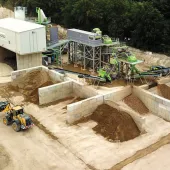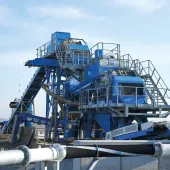New Washing Plant for Roke Manor Quarry

First published in the December 2016 issue of Quarry Management as Modular Plant for Roke Manor
CDE modular washing plant up and running at Raymond Brown’s newest sand and gravel operation
Final commissioning has recently been completed on a new CDE modular sand and gravel washing plant at Roke Manor Quarry, in Hampshire. The site is operated by Raymond Brown, who currently have 11 locations across Hampshire, Dorset, Wiltshire, Oxfordshire and Berkshire. Roke Manor Quarry is the latest addition to the group portfolio, having been officially opened by group chairman Ron Isaac in November 2014.
‘The new site was seven years in development and planning permission was granted in 2011,’ explained Richard Hoare, project manager at Raymond Brown. ‘Our licence will see us extract 750,000 tonnes of sand and gravel at a rate of 125,000 tonnes per year.’
The permission is accompanied by a 30-year woodland management plan that involves additional tree planting in line with an approved landscaping plan that formed part of the planning permission. The site is located 11 miles from Southampton on the outskirts of the New Forest and it was the sensitivity and environmental responsibility displayed by Raymond Brown which resulted in the successful planning application.
Speaking about the Roke Manor development, chief operating officer Steve Clasby said: ‘This is an exciting new opportunity for Raymond Brown. We pride ourselves on our sustainable and proactive approach in dealing with our environmental, social and economic impacts.’
The new washing plant
The new washing plant at Roke Manor will process sand and gravel at a rate of 80 tonnes/h and includes several items of equipment from the CDE portfolio, including an AggMax modular log-washer, EvoWash sand washing plant, AquaCycle thickener and decanter centrifuge, as well as a feed hopper and transfer and stockpile conveyors.
Material is delivered to the plant via an M14 feed hopper with 150mm grid spacings. CDE conducted extensive material testing prior to specifying the plant and the vast majority of material being processed is in the –63mm range, with 80% typically passing 20mm.
‘Raymond Brown were looking for performance guarantees that gave them confidence in the capability of the plant to tackle high fines and clay content in the feed material and produce a range of washed sand and aggregate products that would meet their customers’ requirements,’ explained CDE’s technical manager, Chris McKeown. ‘Our performance statement covers the production of a range of products from the new plant to agreed specifications: 0–4mm concrete sand; 0–2mm building sand; 4–10mm, 10–20mm and 20–40mm aggregates; and a +40mm oversize.’
This agreement was reached after extensive material testing at Roke Manor to establishs to work with customers on the kind of performance statements included on this project for Raymond Brown.’
The feed material is transferred to the first stage of processing via a 23m long conveyor with an 800mm wide belt. At the head of this conveyor, a washbox fluidizes the material before delivery to the AggMax modular log-washer.
Before material enters the AggMax, a double-deck horizontal screen is employed as a pre-screen to remove the +40mm oversize material and the –4mm sand from the feed material. The +40mm oversize is stockpiled in a bay underneath the AggMax, via an integrated 4m long horizontal conveyor with a 650mm wide belt. The feed material contains an average of
9 tonnes/h of this oversize material.
While the top deck of the screen removes the oversize material, the –4mm material passes through the bottom deck of the screen and is sent to the sand washing phase. This is an important step in protecting the plant, as Matt Bunting explained: ‘Log-washers and sand are not a very good combination, as if the sand is allowed to get into the log-washer it will result in excess wear on the machine. By removing the sand fraction at this stage we are able to protect the machine, ensuring maximum plant availability and allowing Raymond Brown to maximize their production volumes and the return on their investment.’
Material from the bottom deck of the pre-screen is delivered to the AggMax modular log-washer at a rate of 47 tonnes/h (on average), whereupon the material is subjected to high levels of attrition before being discharged to a triple-deck sizing screen which is integrated on to the AggMax chassis.
According to CDE, the AggMax is one of their most popular products and is specified on a range of projects from sand and gravel and crushed rock processing to construction and demolition waste recycling and iron ore processing. ‘The design of the AggMax has been refined over the last 10 years to ensure it continues to offer our customers the highest level of scrubbing performance, while also including a range of design features which ensure it is operational for as close to 100% of the time as possible,’ explained CDE’s product development manager, Glenn Sloan.
The most obvious design feature of the AggMax is the arrangement of the paddles in a fan configuration, which not only maximizes the material-on-material impact within the machine, but reduces shock loads on the bearings to deliver extended equipment life and a reduced power requirement.
The AggMax also features enhanced bearing protection, with the main bearing housings located on the outside of the machine. ‘The AggMax bearing arrangement features 13 levels of bearing protection to eliminate the potential for material and water ingress – protecting the machine and ensuring our customers are able to concentrate on meeting their production targets,’ explained Mr Sloan. There is also a bearing temperature sensor which has the capability to automatically shut down the plant if the temperature goes beyond a defined level, thereby maximizing equipment life and minimizing the time required for essential plant maintenance.
The scrubbed aggregates are discharged on to an integrated triple-deck sizing screen to produce the 4–10mm, 10–20mm and 20–40mm aggregate products. These are stockpiled via three 15m long stockpile conveyors with 650mm wide belts.
Any fines liberated from the aggregates during the attrition phase are combined with the 0–4mm material removed at the pre-screening stage and delivered to the EvoWash sand washing plant. The EvoWash produces two sands for Raymond Brown: 0–4mm concrete sand and 0–2mm building sand.
‘Due to the relatively high level of fines in the feed material it is necessary to produce two sands in order to ensure production of a concrete sand spec,’ explained technical manager Chris McKeown. ‘There is a lot of material in the 0–2mm range and the first stage of classification involves the removal of some of this material to allow production of the concrete sand.’
The material is first delivered to a 500mm cyclone and the cyclone underflow is discharged on to the first side of the split EvoWash dewatering screen. The dewatering screen is set up to allow some of the 0–2mm material to fall through to the sump and this is pumped to a bank of three 250mm cyclones. This not only achieves the required removal of the –63 micron fraction, but delivers a slurry containing the 0–2mm material to the second side of the split dewatering screen before this is stockpiled.
The waste water containing the –63 micron fraction is delivered to the first stage of water treatment and recycling where the AquaCycle A200 thickener is deployed. The AquaCycle accepts the feed from the cyclone overflow
The flocculent causes the very fine particles to bind together and sink to the bottom of the AquaCycle tank while the clean water overflows the peripheral weir and is stored in a steel tank for recirculation to the washing plant. This recycles 90% of process water and reduces the fresh water requirement to top-up only.
‘Fresh water for use on the new CDE plant is limited,’ explained Richard Hoare of Raymond Brown. ‘Without the integrated water-recycling and sludge-management system, it simply would not have been possible for us to proceed with this investment in the new washing plant, and CDE were able to demonstrate significant experience and capability in this area.’
The sludge at the bottom of the thickener tank is conditioned by a set of rakes that rotate around the bottom of the tank. The helps to ensure that the sludge can be easily discharged from the tank and also provides the mechanism by which the automatic sludge discharge function is activated. Once the rakes encounter a specific level of resistance the sludge pump is activated and the sludge is discharged into a 106m3 capacity circular steel buffer tank.
As with the AquaCycle thickener tank, the sludge buffer tank is also fitted with a set of rakes, which, as Chris McKeown explained, helps to optimize the performance of the decanter centrifuge. ‘In order to ensure best performance from the decanter centrifuge it is essential that the density of the sludge is consistent. The rakes in the buffer tank help to maintain this consistency, which ensures maximum dewatering of the sludge for maximum water recovery and minimum waste volumes.’
After the sludge has been dewatered a screw conveyor discharges the filter cake to a bay below the centrifuge enclosure. On this particular plant the centrifuge is sized to accept delivery of 8 tonnes/h of solids.
The new CDE plant at Roke Manor Quarry is operational for 10h a day but the decanter centrifuge runs for an additional 2–3h a day after material processing has stopped. This helps to clear the sludge buffer tank in advance of the next day’s production.
‘The advantage of the centrifuge decanter in this instance is the capability for continuous, unmanned operation,’ explained CDE’s Matt Bunting. ‘This allows Raymond Brown to not only reduce the level of operator intervention, but also gives flexibility in the sizing of the centrifuge.’
In addition to the water recovery and recycling benefits offered by the combination of the AquaCycle thickener and decanter centrifuge, these units have also significantly reduced the amount of space required on site by eliminating the need for settling ponds, which are replaced by the waste bay beneath the centrifuge enclosure where the cake is discharged.
‘The entire plant footprint for Raymond Brown, including product stockpiles, is
57m x 48m,’ explained Mr Bunting. ‘If no water-recycling and sludge-management system was in place, the washing plant would require a considerably larger area than this and further cost would be introduced to the project as a result of the requirement to build secure and safe settling ponds.’
‘Another advantage of eliminating settling ponds that cannot be overstated is the health and safety benefits,’ explained Richard Hoare. ‘By removing this risk from our site at Roke Manor we are demonstrating our commitment to best practice. The best way to protect your people is to eliminate the risk and that is what we have chosen to do at here by introducing this closed-circuit water-recycling and sludge-management system.’
Conclusion
Given the location of Roke Manor Quarry, the new washing plant puts Raymond Brown in a good position to take advantage of the aggregate supply opportunities that exist in the Southampton and wider Hampshire area.
‘We’ve got good access to Southampton at only 11 miles from the city centre,’ explained Mr Hoare. ‘We identified the opportunity from an investment at Roke Manor Quarry some time ago and we are delighted to now have the latest materials washing and classification technology in operation. This will allow us to deliver the highest-quality sand and aggregates to the local construction market – something that customers of Raymond Brown have come to expect from us over the last 60 years.’
- Subscribe to Quarry Management, the monthly journal for the mineral products industry, to read articles before they appear on Agg-Net.com








